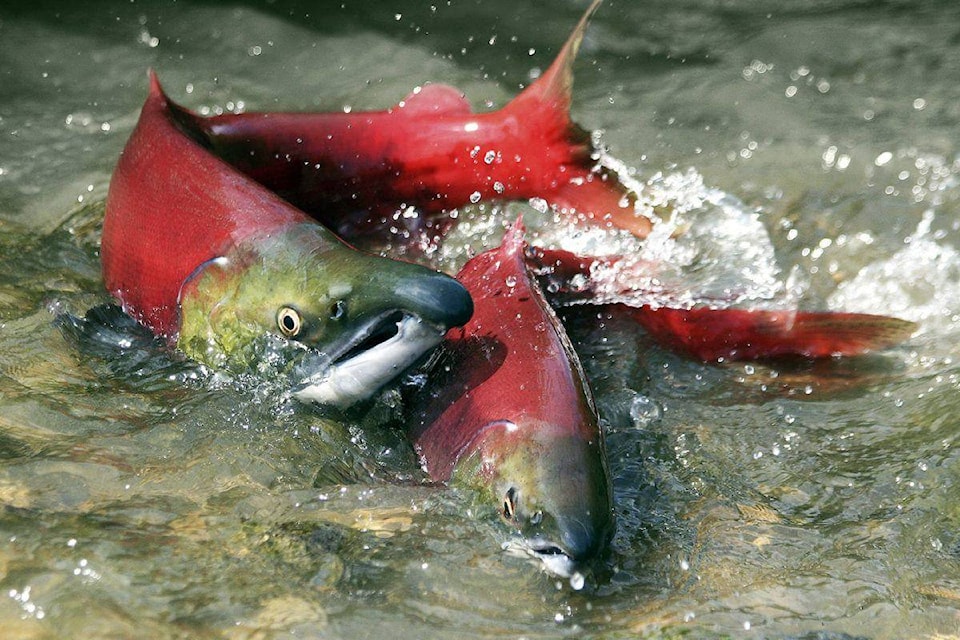Read the full story in the June 28 edition of The Interior News.
Sockeye salmon on the Skeena River are off limits this season.
The Department of Fisheries and Oceans (DFO) announced earlier this month that there are two closures for recreational fishing of salmon on the Skeena watershed. The first closure ends on July 14, which will allow the catching of Skeena Coho, pink and chinook salmon.
A notice from the DFO reads in part, “This closure is being implemented to facilitate First Nations harvesting of Skeena salmon due to predicted low returns of Skeena River sockeye salmon in 2017.”
As for the second closure, it’s for sockeye salmon and it will remain closed for the entire season unless there is an in-season indication of increased Skeena sockeye abundance. The ban includes harvesting by First Nations for food or cultural purposes.
Pierce Clegg, who owned a fishing camp and lodge on the Babine River and has lived in Smithers since 1986, said it’s not surprising that the Skeena River is closed to catching sockeye Salmon..
Toboggan Creek Salmon and Steelhead Enhancement Society is a fish hatchery near Smithers. In their 2017/2018 newsletter they state in part, “Each year we work to enhance and assess local Chinook, Coho and Steelhead salmon stocks in the Bulkley Valley watersheds.”
The letter goes on to read, “The Toboggan Creek coho return last year (2016) was very good, with over 6,600 spawners estimated. Even with thousands of Toboggan Creek coho harvested in Alaskan waters alone in 2016, our escapement last fall was the third largest on record. Our best return occurred in 1999 when over 9,200 Coho returned to the creek, and in the year 2014 we had close to 7,000 Coho escape to spawn.”
Clegg says fish farming is not the answer.
“We can’t have this giant indiscriminate gillnet fishery … we need to put fish back into the spawning beds … we have issues with logging and what it does to spawning beds and everybody’s had a [strong opposition] against LNG and they’re ignoring what damages logging does to spawning beds … You’ve got to look at the spawning beds on the upstream side and on the downstream side you’ve got to let enough fish through,” said Clegg.
If things don’t change, Clegg believes things will only get worse for all fish species.
Business and tourism
Local business owner Alex Bussmann said it’s going to affect the bottom line but that’s not his biggest concern.
“It definitely will affect the bottom line, but we’re more worried about the fish stock in the long run … we’re all about conservation,” he said.
While there’s not a number one reason for the salmon stock to become fewer in number over the years, it’s a compounding problem.
“It’s a dwindling stock, with climate change, with potential over-harvesting of the ocean. There’s a bunch of things going against the species,” Bussmann added.
Bussman can’t recall an entire season being shut down for recreational use but said it’s not the first time they’ve seen a temporary closure.
“There has been closure for sockeye in the past,” he said
As a business owner, Bussmann is informing customers of the closure to sockeye salmon with the hope that people will not catch them so the numbers will increase.
Gladys Atrill of Tourism Smithers believes the closure will impact the community financially.
“For the businesses that rely on either resident anglers or visiting anglers, it makes a difference … If we don’t have resident anglers going out to participate in the sport that they like, which usually precipitates [the] purchasing of gear, etc. Or visiting anglers coming in either on their own or with their families to access the activity that they love, if they don’t come here, well they’re not going to be staying at campgrounds or hotels or motels and they’re not going to purchase all of the services that they would purchases around that stay … if they’re not here, the dollars aren’t spent. So that is certainly an economic impact,” she said.
While it may have a financial impact, Atrill said residents know that conservation is important.
“I think people really do understand the notion of conservation … I think this closure has some mixed feelings for anglers, but the fact that we need to apply conservation measures, I don’t think that’s rejected at all, but it will affect people economically,” she said.
While the Skeena watershed is closed for sockeye fishing, the Kitimat and Nass Rivers remain open.
